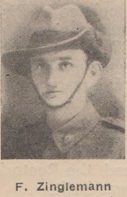
ZINGELMANN, Frederick
| Service Number: | 3221 |
|---|---|
| Enlisted: | 29 November 1916, Enlisted at Brisbane, QLD |
| Last Rank: | Private |
| Last Unit: | 41st Infantry Battalion |
| Born: | Queensland, Australia, 10 January 1890 |
| Home Town: | Boonah, Scenic Rim, Queensland |
| Schooling: | Not yet discovered |
| Occupation: | Labourer |
| Died: | Killed in Action, Belgium, 5 October 1917, aged 27 years |
| Cemetery: |
No known grave - "Known Unto God" Menin Gate Memorial, Ypres, Flanders, Belgium. Panel 27 |
| Memorials: | Australian War Memorial Roll of Honour, Boonah War Memorial, Brisbane 41st Battalion Roll of Honour, Ypres (Menin Gate) Memorial |
World War 1 Service
| 29 Nov 1916: | Enlisted AIF WW1, Private, 3221, 41st Infantry Battalion, Enlisted at Brisbane, QLD | |
|---|---|---|
| 7 Feb 1917: | Involvement Private, 3221, 41st Infantry Battalion, Third Ypres, --- :embarkation_roll: roll_number: '18' embarkation_place: Sydney embarkation_ship: HMAT Wiltshire embarkation_ship_number: A18 public_note: '' | |
| 7 Feb 1917: | Embarked Private, 3221, 41st Infantry Battalion, HMAT Wiltshire, Sydney |
Narrative
Frederick Zingelmann # 3221 41st Battalion
Fred Zingelmann was 26 years old when he presented himself for enlistment in Brisbane on 29th November 1916. He gave his occupation as labourer, his address as Boonah and named his widowed mother Marie Zingelmann as his next of kin.
Fred was allocated as a reinforcement for the 41st Battalion, part of the 11th Brigade of the 3rd Division AIF. After a period of home leave, Fred journeyed to Sydney by train to embark on the “Wiltshire” on 7th February 1917. The embarkation roll shows that he had allocated 3/- of his daily pay to his mother.
Fred arrived at Devonport on 11th April and was marched out to the 11th Training Battalion at Fovant. The bulk of the 3rd Division; which Fred would eventually join, had been preparing for the major offensive in the Ypres salient. The offensive began on 7th June 1917 with the blowing of 19 underground mines along the Messines Ridge. The 41st Battalion had only a minor support role at Messines and by the time Fred crossed the English Channel in August, the 41st was in training for the advance from Ypres along the Menin Road to the village of Passchendaele.
The war diary of the 41st records a successful operation on the Broodseinde Ridge on the 4th and 5th of October which resulted in the capture of enemy trenches and the taking of a considerable number of prisoners and war materiel. Battalion casualties recorded were comparatively light (compared to casualties sustained on the Somme in 1916 and Bullecourt in 1917) with just 36 killed and 200 wounded.
Unfortunately Fred Zingelmann was one of those killed. His death may in part be attributed to his lack of experience as Broodseinde was Fred’s first time in action. It is possible that Fred was buried somewhere on the battlefield but as the battle of Passchendaele went on for another two months before grinding to a halt in the Flanders mud, the location of his remains was lost.
At the end of the war, the Imperial (since renamed Commonwealth) War Graves Commission began the task of establishing and maintaining cemeteries and memorials for the fallen. There were many men for whom no grave nor remains could be found.
Fred Zingelmann is commemorated on the stone tablets of the Menin Gate Memorial in Ypres. He is listed alongside 50,000 soldiers of British Empire who perished in Flanders and have no known grave. The citizens of Ypres each evening conduct a remembrance ceremony under the arch of the Menin Gate to honour their sacrifice.
Submitted 1 September 2021 by Ian Lang
Frederick
Frederick was one of my grandmother's siblings.
He went to war in France to fight for his adopted country against Germany, the country from where his parents came from. One of the many who will always be remembered.
Submitted 25 May 2021 by Brian Larter
Biography contributed by Carol Foster
Son of Otto Zingelmann and Marie (Mary) Ernestine Zingelmann nee Mieland of Boonah, QLD.
Medals: British War Medal, Victory Medal









